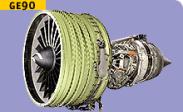Aircraft Engines
N. Lynch
Many people use the air as a form of transportation every day, or use it to protect us. But have you ever really looked at the engine of one of planes and thought about the fact that the metals that make up the engine are working above their own melting point? But if that is the case why don't they melt?
There are many things that prevent this from happening; first there are many things in the casting (forming) process of the part that actually put little tubes and holes through the piece which allow air to pass through the part to allow cooling from the inside. This air actually comes from the air that is pushing the plane in the air. So a reduction in the air needed to cool would mean more air pushing the plane. Coatings can be sprayed onto the parts to improve the melting point of the piece.
Improvements onto these things are what Materials Engineers of today are wrestling with. If different metals can be found with higher melting points less air would be needed to cool the parts so more thrust would be possible and/or higher temperatures would be possible for the engines and higher temperatures mean more thrust. New coatings could also improve the melting point of the piece which would also allow for higher temperatures.

GE90 engine used on the Boeing 777

Turbine Blade
